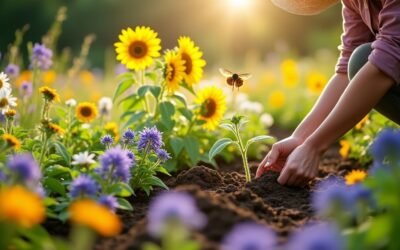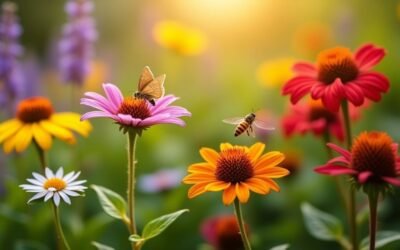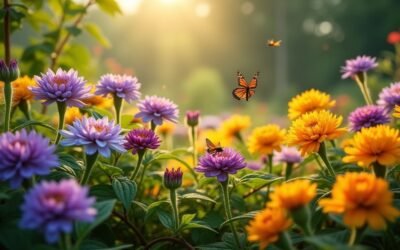Native flowers are pivotal in supporting local pollinators by providing critical nectar and pollen essential for their survival. Species such as red clover and common yarrow not only enhance biodiversity but also improve soil quality, serving as a habitat for butterflies. Vibrant blooms—like those of wild strawberries—attract bees, while deep-rooted plants promote water conservation. By selecting groups of flowers that bloom throughout the growing season, one can create a dynamic environment, optimizing pollination efficiency. The health of local ecosystems thrives when these flowers flourish, illustrating a profound interconnectedness that invites further exploration into enhancing pollinator habitats.
Main Points
- Native plants like Red Clover and Common Yarrow provide essential nectar and food sources for local pollinators and enhance biodiversity.
- Selecting flowers with diverse colors and seasonal blooms ensures a continuous food supply for pollinators from spring to fall.
- Planting in groups increases pollination efficiency, attracting more pollinators to native flowers like Rough Hawkbit and Greater Knapweed.
- Incorporating habitat features such as dead logs can create nesting spots, further supporting local pollinator populations.
- Minimizing chemical use and promoting native diversity is crucial for maintaining healthy habitats for pollinators in your garden.
Importance of Native Plants
While many may overlook their significance, native plants play an essential role in supporting local ecosystems and pollinators.
The native plant benefits include providing vital nectar and pollen for specialized bees and hosting butterflies' caterpillars. Red clover's nitrogen-fixing abilities also contribute to enhancing soil quality, which is crucial for sustainable ecosystems. For instance, Common Yarrow serves as a vital food source for pollinators, particularly butterflies and bees, enhancing biodiversity.
Their deep roots promote water conservation and soil health, underscoring their ecological significance. Additionally, their greater resistance to insects and diseases reduces the need for chemical treatments, further enhancing sustainability in gardening practices.
Understanding the Pollination Process
Pollination is a remarkable process that underlies plant reproduction and supports the survival of many species.
This intricate pollination mechanism involves diverse pollen varieties, which attach to pollinators as they seek nectar. When pollinators transfer pollen from one flower's stamen to another's stigma, fertilization occurs, leading to the formation of seeds and fruits essential for the next generation of plants. Attracting pollinators is crucial for maximizing the chances of successful pollination. Comfrey, with its bell-shaped flowers, attracts a variety of pollinators, providing a consistent nectar source that supports local ecosystems from late spring to early summer. Wild strawberries, known for their distinctive white flowers, also play a vital role in attracting bees and butterflies, further enhancing pollination in their habitats.
Types of Pollinators Benefiting

Local pollinators play an essential role in maintaining biodiversity and ensuring the health of ecosystems.
Bee behavior, characterized by preferences for shallow, tubular flowers, supports crop pollination, while butterfly attraction to vibrant blooms enhances garden diversity. This is particularly evident as flower features significantly influence which pollinators visit specific plants. Additionally, many species of local wildflowers, such as Common Foxglove, provide ample nectar and can attract a variety of pollinators, thereby boosting pollinator populations. The significance of plants like Greater Knapweed in providing a vital nectar source cannot be overstated.
These interactions promote a sustainable environment, linking plant health with thriving insect populations, ultimately enriching the food web and strengthening ecosystem resilience across diverse landscapes.
Selecting Pollinator-Friendly Flowers
Choosing the right flowers is essential for attracting and supporting local pollinators. Selecting native plants guarantees compatibility with local pollinators, offering the necessary nectar and pollen resources.
A diverse array of flower colors and seasonal blooms fosters a thriving ecosystem, providing sustenance from early spring to late fall. By planting in groups, gardeners enhance pollination efficiency, creating a vibrant habitat for various pollinator species. Additionally, incorporating plants like Rough Hawkbit can significantly increase the availability of nectar sources for pollinators throughout the growing season. Yellowwort, with its bright yellow flowers, is a great choice as it serves as a significant nectar source for pollinators, particularly bees and butterflies.
Creating Pollinator Habitats

Creating a habitat that supports pollinators requires thoughtful planning and management.
Effective site selection involves choosing undisturbed areas with open canopies, ensuring ample sunlight, while also considering proximity to diverse crop fields. Incorporating habitat features like dead logs and brush piles offers nesting opportunities. Additionally, including plants like Greater Birds-Foot Trefoil can enhance soil fertility and provide nectar sources for various pollinators.
Minimizing chemical use and promoting native plant diversity fosters a thriving environment for pollinators, enhancing ecological balance. Birds Foot Trefoil, known for its nitrogen fixation and attractiveness to pollinators, can be an excellent addition to your habitat.
Positive Impact on Pollinator Populations
Flowers play an essential role in sustaining pollinator populations. These vibrant blooms attract various species, influencing pollinator behavior and enhancing ecological interactions. By providing nectar and pollen, flowers facilitate the vital food exchange needed for successful pollination, resulting in seed and fruit production. This interaction not only strengthens pollinator numbers but also promotes biodiversity, ultimately supporting a balanced ecosystem that benefits all living organisms. Additionally, flowers like white clover serve as critical nectar sources, helping to maintain healthy populations of important pollinators like honey bees and bumblebees. Furthermore, plants such as Meadow Vetchling enrich soil quality and provide habitat for various pollinator species, further enhancing the ecological balance.


